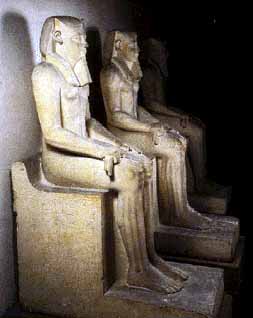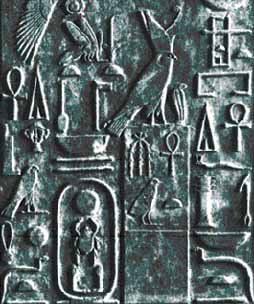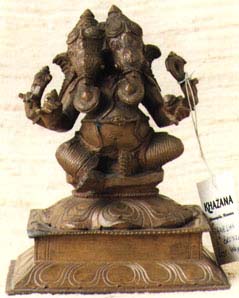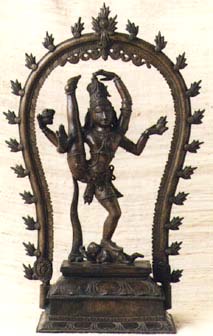
by

The historic gods of Africa and Asia were of Proto-Saharan origin.Concepts concerning these ancient gods or great ancestors were first developed around a gigantic lake that formerly existed in Middle Africa around 8000 years ago. This is supported by the fact that the Saharan cultures have resemblances to those of Nubia. This lake was known in ancient times as Lake Tritonis.
Lake Tritonis was situated in the Libyan desert. Here as early as 7000 B.C., there was a slow transition from hunting , to cattle pastoralism. The prehistoric appearance of a great lake in Libya has recently been supported by satellite pictures of the Eastern Desert which indicate that a lake was located in the Qattara depression of northwest Egypt.
Around 10000 years ago pluvial conditions existed in the Sahara which led to the creation of numerous river beds now buried under tons of sand. Due to the abundance of streams, rivers and lakes in Proto-Saharan Africa men who were powerful, were men who could harness the powerful water of the numerous streams and rivers. Such men as these were recognized as demigods or great ancestors. For example in Sumer and Egypt gods and demigods were described as "reed-boat navigators". In Egypt some of these great men that became gods include Thoth, and Osiris.

The Egyptian Gods Isis, Thoth and Khepri
This is supported by Dravidian and Egyptian traditions. In ancient Egyptian tradition Ptah, came from the Sahara below Egypt in Kush. He found Egypt inundated , so he performed great works of dyking and land reclamation so the land was more habitable.
The first avatar or Tirumal of the Dravidians is regarded as a fish, who showed Manu, a boat to save himself from being drowned. Tirumal,is the same as Visnu of Sanskrit literature, another name for this god is Mayavon, Mayan and Mal.
According to references in the Bhagavata Purana, a fish who is identified with the first avatar (sage), showed Manu a boat nearby to save himself from being drowned . In passing it is interesting to note that the emblem of the Pandya Kings of South India was the fish. Moreover in the Mesopotamian deluge story two Tamil words: nir 'water' and min 'fish' appear.
Moreover, it is interesting to note that the Arivar or sages of the Dravidians were also called Vellalar "lords of the flood " or Karatar "lords of the clouds". These sages earned these titles because of their skill in controlling the floods and in storing water for agricultural purposes.
According to the Olympian Creation Myth the earliest groups to appear on earth were the Libyco-Thracians. The Libyans were Proto-Saharans, as were the original Thracians, who were descendants of the Kushite and Egyptian troops established at Trace , by Sesostris (Thutmose III or Ramses II),when he conquered Asia and Europe.
Apollonius Rhodius tells us that the goddess Athene was born beside Lake Tritonis in Libya. The goddess Athene, was called Neith by the Egyptians and Nia, by the Manding and Eteo-Cretans of Minoan civilization.
The early gods of these Proto-Saharans included a serpent, the sun: Hercules, Amon/Aman/Amma, and Kush or Khons. In Egypt and Kush, both Amon and Khons were depicted as coal-black in accordance with tradition. The Kushites also worshipped a "lord of the mountains", which is analogous to Murugan, a Dravidian god in India. In India, Khrisna, Mal ,Vishnu, and Kali were usually depicted as black in color. Kali, was held to be a form of Paravati, consort of Siva. In addition the Dravidian god of the pastoral region:Mullai, was the black god Mayan, who was beloved by the milkmaids and cattle herders.
The earliest gods associated with the great hidden all powerful god were associated with the Sky. They believed in an unseen universal force called "Ko " or " Ka". As a result the Proto-Saharans offered prayers to "Ka", e.g., Egyptian Ka 'vital force', Dravidian Ka-n, Manding Kani, and Magyar/Hungarian kaan. This Ka, is also often associated with snakes,rain and the sky.
THE GOD MAA
Many of the Proto-Saharan beliefs originated during the wet African Aqualithic period. As a result their gods, who had once been great ancestors were referred to as "Fish" or "reed-boat navigators". This common god was called Maa , the man fish (of Eridu) in Mesopotamia and Syria and the ithyphallic forms, the prototype of Amon/Aman in Egypt ; and the goddess Minaksi, of Madura in South India the goddess of the fish eyes, the Malabar fish bearer of Mana and the sacred fishes of the Mapilla of the west coast of the Dekkan. In the languages of the Manding Maa, is used to refer to the ancient inhabitants of the African continent, and the invisible spirit who inhabits the water courses.In Egypt Maat, meant divine truth and justice.
Among the Proto-Saharans the name Maa, for their great ancestor/god was joined to many ethnonyms. The descendants of the Maa clan, claim descent from Maa, as evident in the name Mande, for the parent group of the Manding of West Africa. Mande means, Ma-nde or "children of Ma". Some Dravidians of South India were also members of the Mande Superclan, as illustrated in the Kannada, Telugu and Tulu, Dravidian tribes that use the terms Mande or Mandi to denote "people or persons". The Sumerians called themselves Mah-Gar-ri "God's exalted children".
The Proto-Saharans in honor of great Maa, use the term "ma", to denote greatness, for example Manding: Maga; Sumerian: Mag; and Dravidian: Ma.The ma, element was also used in the names for their rulers e.g., Menes of Egypt; the Mannan of the Dravidians; and the Mansa of the Manding.
The Mal, of the Dravidians is just another form of Ma. Mal, is the Fish. He was the prototype of the Fish god among the Pandyan-Tamils. Ama, Uma, Ammon, Amon, and etc. seems to either refer to Mal's consort.
This goddess Amon is most ancient among the Proto-Saharans.This goddess has many names including Athene or Neith, daughter of Poseidon god of the Sea (again reference to the great Fish-man); and Demeter, the mare headed patroness.
The Mother goddess Amma/Amon of Libya had her cult center at the Oasis of Siwa. In ancient Egypt Amon was depicted as a ram with spheres. The god Amon was taken to Egypt during the New Kingdom.

The god Amon
The Proto-Saharans early used the oxen with sun disc between the horns as the symbol of their God, long before the Egyptians worshipped Hathor. This god represented Amon/Amma of the Dravidians, Egyptians and Manding speaking people.
Engravings in the Sahara, dating back to Neolithic times show the solar disk with "uraei", which was associated with the worship of Ra/Re in Egypt, when worn by the ram it represented Amon of Thebes. There are depictions of this god from the Saharan sites such as Bou Alam and Zenoga. Archaeologists believe that these engravings date back to 4000 BC. This use of a ram god, with different names among the various groups indicate that the Proto-Saharans worshipped the same religion.For example among the Dogon of West Africa, the god Amma is a ram. In Yoruba Amon, means concealed the same as in Egyptian."
Amon/Athene
This worship of the ram may have resulted from the important part goat/sheep played in the Sahara as a source of food when the Sahara increasingly became more arid.
It is interesting to note that Siwa (> Siva?), was recognized as the cult center of Amon/Amma, because in the Siwa depression archaeologists have found numerous conical and pyramidal sand encrusted hills that resemble the monuments of ancient Egypt, including a sphinx which resembles a gigantic ram. Although most scholars believe these monuments in the Siwa and Farafra Oasis are natural erosional formations called yardangs, they may really be the remains of monuments built by the Proto-Saharans now encrusted with sand harden by the wind.
The mother goddess was either identified as Amon or Athene. Amon or Amen of the Egyptians was primarily a Theban god whose shrine was rebuilt around 2500 BC, when the Theban Kings defeated their northern foes. Amon became an important god in Egypt beginning with the 12th Dynasty . The priests of Amon, called their god "the King of Gods". The Egyptians recognized Amon as a primeval god. Amon is identified with the ithyphalli god Men( Maa ?)
Amon was recognized as an unseen god, because he could travel. He was also seen as an imperial god. Sesostris I, is credited with building the Temple of Amon at Karnak, near Thebes. Sesostris I, is also credited with conquering the whole sea coast of India, beyond the Ganges to the Eastern Ocean, he also conquered Europe as far as Thrace.
It is clear that Amon or Amen, was the ancient god of the Kushites/Proto-Saharans because Ammenemes I or Ameny I of the 11th Dynasty was from the southern state of Ta-Seti, the first Nome (city/state) of Egypt. Ammenemes means "Amon is in front".

Sesostris
Sesostris I (Thutmose I), probably helped establish Amon worship in Europe and Asia , because as he expanded his Empire he left colonies in all the lands he conquered. Sesostrasen Osiritasen of the 12th Dynasty, is suppose to have established colonies along the Danube river and the Black Sea. Strabo (Bk.3), said that Sesostris I, is suppose to have conquered Palestine, Syria, Mesopotamia, Armenia, Iberia and Colchis.

The Hieroglyphic name of Sesostris
Before the Egyptians conquered Greece the worship of Amon had already been established in the region. It was the Garamante Manding speaking tribe who took Amon worship to Greece. In Appollonius Rhodius iv.1310, we discover that the goddess Athene was born beside Lake Tritonis in Libya. Plato, identified Athene of Athens with the Libyan god Neith. Athene was worshipped by the Manding and other Western Saharans including the Linear A people of Minoan Crete. Athene is always associated with the god Amon. Moreover the Manding concept of N'ama as a dynamic spirit among the other Mande tribes point to an earlier worship of Amon, before the Mande accepted Islam. The Bambara call their ancestral god Gnia or Nia, this has affinity to the Greek term for the Libyan god called Neith. It is interesting to note that in the Linear A inscriptions we find mention of the goddess Nia= Neith. Moreover, some South Indian worship Amma = Amon. The priest of this cult are called Chom or Khonrini, the Greeks called them Gymnosophists. This Chom, of the Dravidians has affinity to Khon, the leading Kushite god.
The goddess Neith or Athene was known by many names. Some names related to Athene include Anaitis, Nanaia > Tanit of the Phoenicians; Nama in Albania; and the Sumero-Dravidian Ninni-Istar "the wild cow".
The Proto-Dravidians and Sumerians had common religions. For example in the Sumer pantheon the emblem for Inanna, was the date palm, while Ninsun, Dumuzi, Anu and Ishkur were associated with bulls. The Dravidian equivalent to Anu, or bull worship was Anu-Rupa or Siva. The name of this clan in India was called Anu. Many of these Dravidians were also established in Armenia.
In India we find the "men with horns". This term was given to Dravidian dignitaries who had crowns made of animal horns. This type of horned figure appear on many Harappan seals, as do serpents. The wearing of animal horns on crowns may date back to the time of Sesostris, because many Egyptian headdresses included horns.
In ancient Sumer, the goddess of the marriage rites was Ur. The goddess Ur, has analogies to the Dravidian cult of the goddess Paravati, in Siva temples.
Dumuzi
The Sumerian god Dumuzi, may be a great ancestor of the Tamil. Prof. Muttarayan has suggested that the word Tamil, may be an evolute of Dumuzi, the name for the Sumerian moon-god. Originally Tammuz/Damuzi was supposedly a king of Uruk. According to Sumerian tradition Dumuzi lived in the neither world.

The Harappan gods were represented as animals on seals. The Unicorn seal depicts Mal (Vishnu or Kataval). The castrated bull on some Harappan seals was probably the goddess Kali. Siva was probably the short horn bull on some Harappan seals, while the elephant represented Ganesha or Pillayer.
The Dravidian people are the descendants of the Harappan people They call Ganesha: Pillayar. They recognized Pillayar as the shrewdest of animals. He is associated with Harvest time, abundance and good luck.

In the neither world of the Harappans there was a place called "lapis luzuli mountains".The Dravidian speakers founded the Harappan civilization and wrote the Indus Valley seals. The miners from the Indus Valley controlled the lazurite ores of Badakhshan and Afghanistan. The Dravidians exported these metals to Mesopotamia.
Lapis lazuli is found in metamorphic limestone or dolomite. This material was used to make many prestige items in the ancient world. The riches source of lapis lazuli was Badakhshan . Other lazurite deposits are found in the Himalayan region, and the southern end of lake Baikal in Soviet Union. These centers of lapis lazuli were the central factor in Dravidian colonization of Central Asia.
The Sumerian story about Dumuzi,probably records the expansion of the Proto-Saharan tribe from Mesopotamia into Central Asia that later became the Tamil. Dumuzi, was suppose to have been exiled from the Sumerian city of Erech or Uruk, by the "demons" of either of these cities. The phonetic laws operative in Dravidian offer no problem in deriving Tamil from Dumuzi.
The marriage of the Dravidian cult goddess Paravati, in Siva temples to insure effectively the fecundity and prosperity of the Dravidian people is analogous to the holy marriage of Dumuzi and Inanna, the Sumerian mother-goddess. The Telugu, call the Dravidians aravaalu "noise makers". This noise made by the Tamils, may have been ritual wailing , one of the major features of the Dumuzi cult in Sumer.
The possible ancient exile of people from Sumer to Proto-Dravidian sites would explain the genetic unity of the Sumerian and Dravidian languages. Interestingly, the Sumerians called themselves proudly sag-gigga"the black headed people". In Tamil gig, means black. This points to analogy between Sumerian and Dravidian. During the reign of King Asoka, of India the Dravidians were called Kalinka, which appears to be an evolute of Sumerian (sag) gigga .
The Sumerians obtained lapis lazuli from the Harappo-Dravidians. S.Kramer, in the Sumerians, claimed that the Indus Valley was called Tilmun/Dilmun by the Sumerians.
The association of Hercules with arrows clearly indicate that he was related to the Kushites who used the bow. Thus Hercules is identified with Khrisna and Mal of the Dravidians.
Poseidon
According to Greek traditions the father of Athene or Neith was Poseidon or Potidan "he who gives drink, the wooden mountain". Poseidon was the god of the sea, his symbol was the trident.
The identification of Poseidon, with a "wooden mountain" or boat(i.e., a boat on the ocean is like a mountain on the sea) suggest that Poseidon, is another name for the Fish, that showed Manu or Maa the boat that saved mankind from the ancient great flood. The identification of the trident ( which also has affinity to the serekh sign of kingship in Egypt and Ta-Seti), and the Fish emblem of the Pandyan Kings show the spread of the Maa worship from Middle Africa to India. The agreement of Poseidon's name Potidan with Pandyan suggest that this god was popular among the Proto-Dravidians.
The identification of the Fish, with Maa and Manu, suggest that while the Fish or Poseidon was the inventor of boats, Maa or Manu built dams that controlled the water levels in areas settled by the Proto-Saharans where they cultivated their crops.
It is interesting to note that when Eudoxus of Cyzicus visited the coastal regions of Kush, Strabo reports that he called this area Posidonius. This is interesting because the ancient people of Abyssinia and Somalia, were said to be Icthyophagi, who worshipped the god Poseidon.
Siva
Siva, was probably introduced into India by the Kushana and Tamilitti Dravidian speaking tribes as they fled from Southeast Asia and China, through Tibet into South India. The symbol of Siva are three eyes (the all seeing), tiger skin, armed with a battle axe riding on a bullock.

Siva
This indicates that Siva was the god of a people that had conquered the worshipers of Mal (as bullock and fish) and also Murugan (who was symbolized by the Tiger) the god of the mountains. Siva's riding of the bullock, suggest defeat of the mother goddess (worshipers) and rise of a patriarchal clan system as a result of the many wars the Dravidians had to fight against the Indo-Europeans, Altaic speakers and Sino-Tibetan speakers in China and Central and Southeast Asia.
Kanakasabhai believes that Siva worship, came from the Himalayan region. He said that "His [Siva's] abode was the snowcapped mount Kailas situated north of the Himalayas, near the sources of the great rivers Ganges, Indus and Brahmaputra. His greatest feat was the destruction of Tripiura or the "three castles" which were the strongholds of Asuras who had caused mush annoyance to the celestials. He married Par[a]vati, the daughter of the king of the mountains" .
Siva is also sometimes analogous to the fish god Mal. In South India, Siva is referred to as the "Great Fish", and is represented by Fish signs.Throughout Tamilnadu tridents are found in association with Siva temples.
Kumara
Among the Dravidians the god of youth is called Kumara or Skanda in the Puranic literature. Kumara is said to be the son of Siva. This Kumara is analogous to the Egyptian god Horus, the son of Osiris.
The above evidence indicates that just as theorized by Diop many of the Proto-Saharan gods were really great ancestors, e.g., Dumuzi, Mal and etc. This proves that except for these great ancestors the Proto-Saharans had a great god which they saw as being far away from them , but firmly in control of events on earth.
Anta Diop has shown that the structure of kinship depends much on the material conditions of life. This rule/theorem can be tested by the Proto-Saharans.
As outlined earlier the Proto-Saharans lived an idealized life where there was abundant food resources until at least 3000 B.C. This situational experience led to the development of a semisedentary lifestyle. After 4000 B.C., as outlined in the previous chapter the Proto-Saharans began to raise cattle in addition to collecting grasses for food. Because of the successful use of first goats/sheep and later cattle, this animal began to represent their gods. This abundance of food led to a Proto-Saharan cosmology imbued with optimism.
